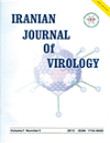فهرست مطالب
Iranian Journal of Virology
Volume:6 Issue: 2, 2012
- تاریخ انتشار: 1391/12/25
- تعداد عناوین: 6
-
-
Partial Quality Control of Inactivated Split Human Influenza Vaccine 2008-9Pages 1-7Background And AimsInfluenza vaccine is one of the best ways to prevent and control influenza worldwide. It is manufactured by WHO-licensed companies based on the WHO expertise committee annually. The aim of this study was partial quality control of the commercial human influenza vaccine 2008-9 and its matching with the circulating strains.Materials And MethodsThe trivalent imported vaccine was cultured in bacterial and fungal media, injected to the mice and inoculated into the allantoic cavity of Embryonated Chicken Eggs (ECEs). hemagglutination-inhibition (HI)assay was carried out on pre and post vaccination serum samples. The bacterial endotoxin was assessed by LAL assay. The hemagglutinin (HA) content of the vaccine was measured using SRID. Heterogenecity of the circulating influenza strains during 2008-9 seasons in Tehran in comparison to the vaccine strains was determined.ResultsNo bacterial contamination and no occurrence of mortality and morbidity in animal was observed. The mean fold increase of HI antibody titer in subjects without previous vaccination for H1N1, H3N2 and B strains were 6.7, 3.3 and 1.8 respectively, while in subjects with previous vaccination were 4, 1.6 and 1.1 for same strains. Amino acid variation was found in Tehran H1N1 isolates but the H3N2 isolates showed higher genetic resemblance to the 2008-9 vaccine strain.ConclusionThe sterility, safety, and efficacy of the vaccine were approved and there was some variation in A/H1N1 but not in A/H3N2 isolates in comparison with the vaccine strain.
-
Pages 8-11Background And AimsThe aim of this study is the cloning and expression of rabies virus glycoprotein by a eukaryotic expression plasmid pcDNA3.1(+) in BSR cell line. This construct might be used as a potent DNA vaccine.Materials And MethodsGlycoprotein gene was synthesized and cloned into pBluescript vector and then sub cloned into eukaryotic expression vector (pcDNA3.1(+)). After verification of the cloning, the recombinant plasmid was transfected into BSR cell line (a clone of BHK-21 cell), and its expression was detected by RT-PCR.ResultsThe authenticity of the recombinant plasmid pcDNA3.1(+)-Gp had been confirmed by quick check method and restriction endonuclease digestion analysis, and after transfection into eukaryotic cells, the presence of mRNA transcripts was verified by reverse transcriptase-polymerase chain reaction (RT-PCR).ConclusionThis study demonstrated that the construction of eukaryotic expression plasmid for rabies virus glycoprotein is possible. Nevertheless, more work is necessary to develop this kind of vaccine for final use.
-
Pages 12-17Background And AimsEach year, the influenza virus causes moderate to severe infections with a high prevalence throughout the world. Accordingly, an influenza vaccine that ensures protection with only a single dose would be a much more cost effective approach to influenza prophylaxis. Generation of Influenza non-replicating virus-like particles (VLP) in baculoviral expression system is an attractive method for achieving this goal. One of the main components of such particles is Neuraminidase surficial glycoprotein that has important role to elicit humoral and cellular immune responses.Materials And MethodsIn this study, the NA coding region amplified from the human influenza virus [A/New Caledonia 20/1999/ (H1N1)] and used to construct the NA recombinant bacmid into E.coli DH10Bac cells.ResultsAfter verification of the new recombinant bacmid, it was transfected into the Spodoptera frugiperda (Sf9) insect cell line to generate recombinant baculovirus expressing the NA gene. The expression of NA in insect cells was confirmed by SDS-PAGE and western blot analysis.ConclusionThe recombinant baculovirus expressing the NA gene can be used in construction of influenza VLP when co-infect along with the other monocistronic baculoviruses expressing influenza Hemagglutinin and Matrix antigens. Moreover, the NA protein expressed in insect cells might be fully glycosylated and therefore appropriate to use in influenza vaccinology projects.
-
Pages 18-25Background And AimsHepatitis C virus (HCV) can cause hepatocellular carcinoma (HCC) in a significant proportion (≈ 20 %) of individuals with chronic HCV infection (CHC). Currently, CHC is treated with peginterferon and ribavirin, which depending on genotype approximately 50 to 70% of patients are cured. The so-called “extrahepatic HCV infection” or viral replication in regions of the body other than liver, e.g. peripheral mononuclear cells (PBMCs), is likely to contribute to the lack of response to treatment in non-responders. In this study, HCV infection of PBMCs was compared between responders- and non-responders HCV-infected patients.Materials And MethodsRT-nested PCR was utilized to detect the plus- and minus- strands of HCV RNA in PBMCs using type-specific primers specific for the HCV core region.ResultsBoth the plus- and the minus strands of HCV genome were significantly lower in PBMCs of responder- than non-responder patients.ConclusionThe presence of both plus and minus HCV strands in PBMCs was associated with the treatment outcome, such that HCV infection of PBMCs was identified in higher proportion of non-responders relative to responders.
-
Detection and Molecular Characterization of Avian Metapneumovirus in Iran: The First ReportPages 26-31Avian pneumovirus (APV) causes turkey rhinotracheitis (TRT) and swollen head syndrome (SHS) of chickens, which is usually accompanied by secondary bacterial infections that increase mortality. In Iran, some serological studies indicated that APV infection is endemic in commercial poultry industry. In this study we diagnosed APV genome molecularly in suspected broiler flock (4 weeks) in Iran and characterized APV genome based on G glycoprotein. In phylogenetic analysis PCRLAB/HG2010 is located in B subtype cluster and near APV strains from Nigeria, Japan and Brazil. It is the first molecular epidemiology study on APV in Iran. In conclusion, vaccination programs in the Iranian poultry industry should be adjusted to include the APV vaccine to aid in the control of this respiratory disease. It is also concluded that more work is required to isolate and characterized AVP in different geographical regions of Iran and different species.


